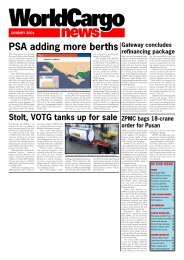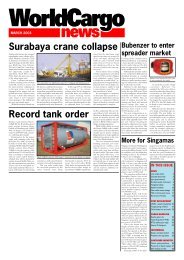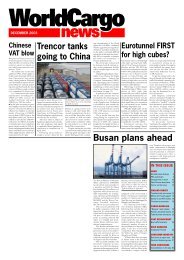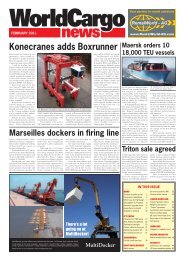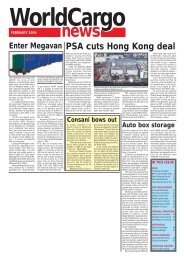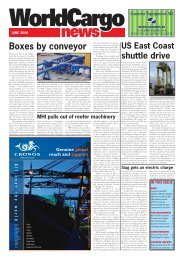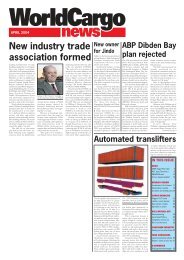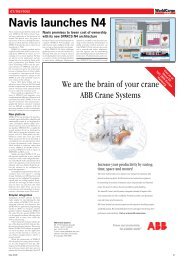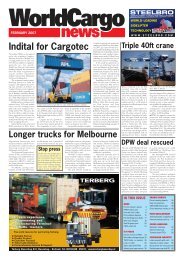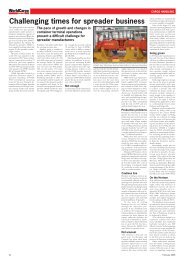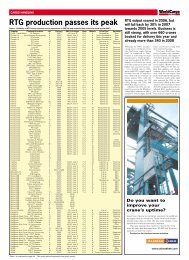US-built box crane - WorldCargo News Online
US-built box crane - WorldCargo News Online
US-built box crane - WorldCargo News Online
You also want an ePaper? Increase the reach of your titles
YUMPU automatically turns print PDFs into web optimized ePapers that Google loves.
SWEDEN/DENMARK: PORT DEVELOPMENT<br />
<strong>WorldCargo</strong><br />
news<br />
Gothenburg reviews its strategic options<br />
As containerisation grew and it<br />
became the accepted policy that<br />
deep sea container ships would<br />
turn around at Hamburg/<br />
Bremerhaven, most Baltic ports<br />
resigned themselves to the rôle of<br />
feeder status with domestic cargoes<br />
no longer shipped direct.<br />
Indeed, the two major northern<br />
European feeder operators,<br />
Unifeeder and Team Lines, were<br />
established to service Baltic cargo<br />
flows and have continued to grow<br />
- Team Lines is now owned by<br />
Finnlines while Unifeeder maintains<br />
its Danish ownership.<br />
Norway’s capital city port,<br />
Oslo, “accepted the inevitable”<br />
and downgraded its container flow<br />
forecasts. It now appears intent on<br />
removing this activity completely<br />
from its port boundaries. Helsinki<br />
welcomed feeder traffic, with regional<br />
ports servicing the paper<br />
industries by ro-ro.<br />
Stockholm and Copenhagen<br />
looked to distance themselves<br />
from commercial container traffic<br />
and instead exploit waterside<br />
development potential as well as<br />
cruise and passenger ferry traffic,<br />
as Helsinki has also done.<br />
Many ports in the Nordic region<br />
appear to prefer real estate<br />
development to port activities,<br />
despite the presence of a concentrated<br />
hinterland in otherwise<br />
sparsely populated countries.<br />
Gothenburg, however, has taken<br />
Sweden’s main load centre has<br />
come up with new ways to extend<br />
its influence in the Baltic area<br />
Maersk Sealand’s GUDRUN MAERSK, here shown being loaded for the first time<br />
at the Port of Gothenburg’s Skandia terminal<br />
a different stance to maintain its<br />
deepsea business aspirations,<br />
alongside feeder traffic.<br />
Not easy<br />
This has proved to be a difficult<br />
task. ACL has stayed with the port<br />
as it had a wider cargo base in<br />
terms of wheeled traffic and machinery.<br />
Evergreen, on the other<br />
hand, tried direct calls but found<br />
the cargo generated did not justify<br />
the deviation and it returned<br />
to feeding to/from Hamburg.<br />
However, according to some<br />
analysts, there is now a shortage<br />
of feeder vessels as pressure on<br />
feeder rates is making longer term<br />
newbuilding investment difficult<br />
to justify. Additionally, new work-<br />
Gottwald Port Technology<br />
ing hour directives may require<br />
additional crewing, particularly to<br />
cover the Elbe/Kiel Canal passage,<br />
which will push up costs against<br />
the same revenue base.<br />
At the same time, the order<br />
boom in main line ships, particularly<br />
post-panamax vessels, as capacity<br />
increases rather than replacement<br />
tonnage, could result in<br />
more ships to service other European<br />
ports outside the Le Havre-<br />
Hamburg range in a “trickle<br />
through” effect.<br />
Blue is the colour<br />
Maersk found better market conditions<br />
than Evergreen for direct<br />
calls, possibly due to its<br />
Scandinavian origins, but more<br />
directly, to its take-over of Sealand.<br />
This <strong>US</strong> carrier was a pioneer<br />
in Gothenburg (although it later<br />
switched to nearby Wallhamn due<br />
to labour disputes and cost issue)<br />
and developed a strong local customer<br />
following in Scandinavia.<br />
So did Sweden’s East Asiatic,<br />
which Maersk also absorbed.<br />
Doubling up for NETSS<br />
To support growing SECU traffic<br />
as StoraEnso’s system is enlarged<br />
to cover Finland, using<br />
Gothenburg as the consolidation<br />
base, the Port of Gothenburg is<br />
constructing another linkspan at<br />
the StoraEnso terminal.<br />
ºUnlike the original 2-tier<br />
ramp, the new linkspan, to be<br />
supplied by TTS, will be a single<br />
level ramp. It will be hinged<br />
at the shoreside and raised and<br />
lowered by means of hydraulic<br />
cylinders at the seaward side.<br />
The 14.5m long by 24m<br />
Our Experience – Your Advantage<br />
Smits Spreaders Systems<br />
The Danish group’s high profile<br />
in Sweden will be further<br />
strengthened by its takeover of<br />
P&O Nedlloyd, which has traditionally<br />
been very strong in Scandinavia,<br />
both in container traffic<br />
and short sea ro-ro.<br />
Encouraged by Maersk’s presence,<br />
the port owner and operator<br />
(Göteborgs Hamn AB) took<br />
the decision was taken to order<br />
two Noell post-panamax <strong>crane</strong>s,<br />
even though it was considered a<br />
risky move. This investment has<br />
evidently proved its worth.<br />
The port has now ordered<br />
three superpost-panamax <strong>crane</strong>s<br />
covering a 23-wide deck span for<br />
wide ramp will cater for three<br />
lanes simultaneously. It will<br />
mainly be used to discharge the<br />
three 13,800 dwt B&N ro-ros<br />
(in build) on the forthcoming<br />
north Finland-Gothenburg<br />
shuttle, as well as load SECUs<br />
into the DFDS Tor Line ro-ro<br />
ships headed for Tilbury.<br />
The ramp, positioned at<br />
berth 702 alongside the original<br />
ramp at berth 700, is aligned<br />
parallel to the quay. Handling<br />
can be carried on at both ramps<br />
simultaneously. ❏<br />
B&W Bulk Handling<br />
Sino-Danish “superport”<br />
Plot A/S, a Danish architectural<br />
consultancy company, is working<br />
on an offshore port project for the<br />
Gulf of Tongking area, as the entry<br />
point to China’s Guangxi<br />
province and the northeast cornerstone<br />
in South east Asia.<br />
The Danish project team is led<br />
by Bjarke Ingels and Julien de<br />
Smedt and its Chinese partner is<br />
the Guangxi Institute of Architecture<br />
Design and Research. The<br />
proposed Red Star Harbour<br />
would occupy 680-ha. Project cost<br />
has been estimated at €1 bill.<br />
Plot has previously proposed<br />
a similar, star-shaped harbour<br />
project for Denmark. This<br />
“superharbour,” located along the<br />
planned Rødby-Puttgarden<br />
bridge, would be the new Baltic<br />
gate. Gradually it would be able<br />
to absorb all Danish harbour activities<br />
and, it was claimed, free up<br />
€20 bill worth of prime, waterfront<br />
space in the existing ports<br />
for residential use. This value was<br />
said to exceed the entire cost of<br />
the new multi-cargo port, so it was<br />
economically good for Denmark.<br />
Its container capacity would be<br />
able to exceed that of Rotterdam.<br />
Plot has been involved in a<br />
number of projects in various<br />
spheres in Denmark, Sweden,<br />
Holland and Korea. However, the<br />
star harbour concept is easily its<br />
most ambitious to date. ❏<br />
Your Partner in Scandinavia<br />
MRS Greifer<br />
E-Crane<br />
Also for Used Equipment<br />
Good results for ADP<br />
Associated Danish Ports A/S<br />
(ADP) reports that revenues rose<br />
by five per cent in the first half of<br />
2005, from DKK42.3 mill in the<br />
first half of 2004 to DK 44.4 mill.<br />
ADP reports a high level of<br />
activity at its three ports (Fredericia,<br />
Nyborg and Middelfart),<br />
with the total volume of cargo<br />
handled increasing by just over<br />
four per cent relative to the first<br />
half of 2004. Despite the lack of<br />
raw material tonnage for Kemira<br />
GrowHow A/S, which closed<br />
down its fertiliser production in<br />
2004, “we have created growth<br />
and attracted new customer activities,”<br />
explains ADP’s managing<br />
director Jens Peter Peters.<br />
Liquid bulk throughput rose<br />
by six per cent, attributed to the<br />
large volume of crude oil shipped<br />
in April and May. Dry bulk volumes<br />
tend to fluctuate more.<br />
There is still a shortfall in grain<br />
shipments, but ADP retained its<br />
importance for shipping animal<br />
feedstuffs. Shipments of stone, sand<br />
and gravel doubled, while general<br />
cargo throughput was up by more<br />
than 20 per cent.<br />
Fredericia saw an increase of<br />
just under five per cent overall,<br />
while cargo volumes increased by<br />
more than 17 per cent in Nyborg.<br />
This growth occurred exclusively<br />
at the Lindholm terminal and is<br />
attributable to new agreements<br />
which have been made concerning<br />
the use of the port for shipments<br />
of broken stone for the<br />
whole of Funen.<br />
Nyborg was chosen, says ADP,<br />
on account of its water depth, the<br />
many free areas and its proximity<br />
to the rest of the infrastructure.<br />
Middelfart has also been used for<br />
the shipment of considerable volumes<br />
of broken stone. Steel volumes<br />
in Nyborg were constant,<br />
whereas the influx of liquid products<br />
to Avernakke was less than in<br />
the same period last year.<br />
The outlook for the second<br />
half of 2005 is positive, says ADP.<br />
Recent months have seen the<br />
conclusion of several new agreements,<br />
which will result in further<br />
increases in cargo volumes. For<br />
2005 as a whole, says Peters, ADP<br />
expects a profit before financial<br />
items of at least DKK20 mill.<br />
Owning and operating the<br />
ports in Fredericia, Nyborg and<br />
Middelfart, ADP handles more<br />
than 17 mill tonnes of cargo a year<br />
and is the largest port system located<br />
within Denmark. ❏<br />
Heavy duty pavements<br />
● Rapid application<br />
● High bearing capacity<br />
● Superior resistance to rutting<br />
● Impermeable<br />
● Joint-free<br />
pavement<br />
www.densit.com<br />
www.port-trade.com Tel.: +45 7628 0102<br />
Reference: Copenhagen Port, Denmark<br />
<br />
September 2005 29



